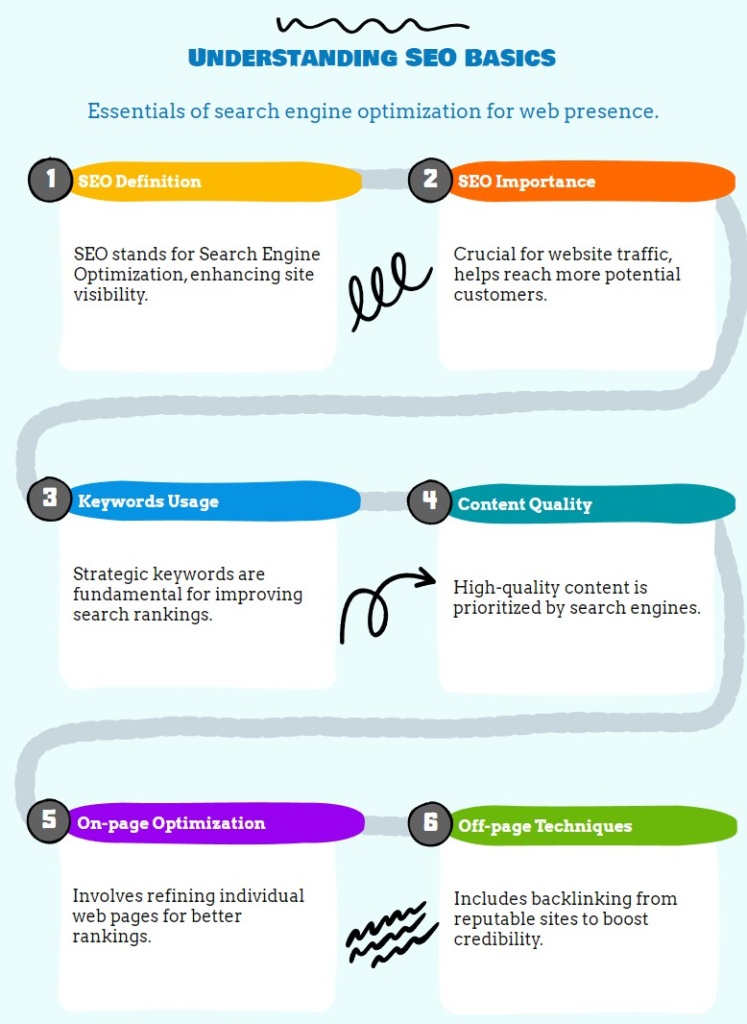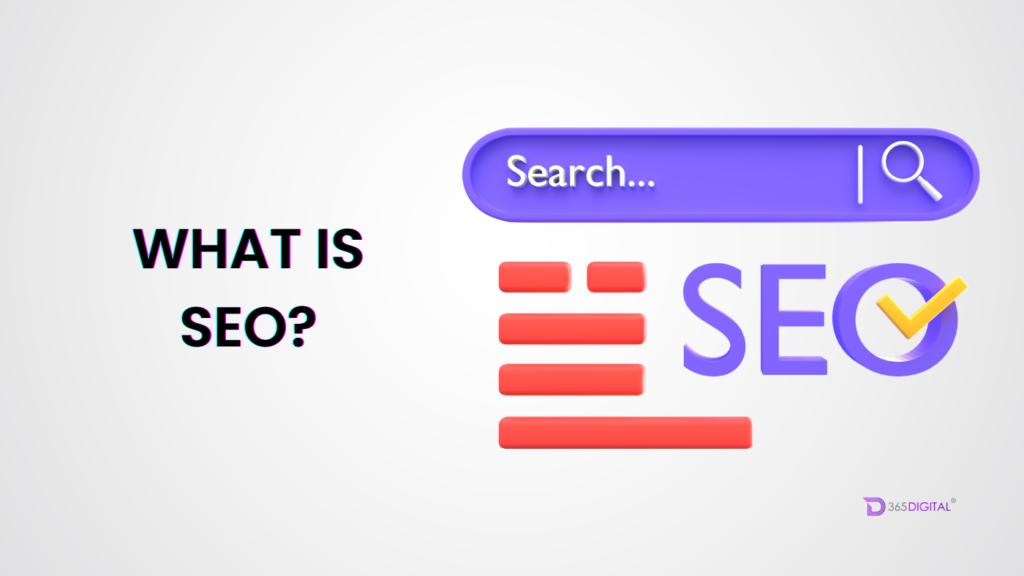SEO is all about optimizing content to rank higher in search engine results, enhancing visibility, and driving organic traffic. We’ve got to understand search engine’s algorithms, which consider over 200 factors like relevance, quality, and user intent.
It’s important to focus on techniques like keyword optimization, creating high-quality, customer-centric content, and building quality backlinks. Learning to make use of Google Search Console or improving mobile-friendliness can also make a significant difference.
It’s a complex process, but with deeper exploration, you’ll discern more about how strategic SEO practices can transform your online presence.
Understanding SEO Basics
To truly grasp the concept of SEO, we need to initially comprehend its fundamental components – optimizing website content for better visibility, understanding the role of search engine algorithms in ranking web pages, and appreciating the significance of organic traffic in online user searches.
SEO basics go beyond simple keyword stuffing; it’s an art and science of strategically positioning a website to be both appealing and accessible to search engines and users alike.
We’ve to take into account crawling, indexing, and ranking, which are key processes in search engine operations. These processes work collaboratively to improve website ranking, consequently driving more organic traffic to your site. It’s a well-known fact that organic traffic covers a significant portion of online user searches, and this is precisely where SEO shines.
In this increasingly digital age, the importance of SEO cannot be overstated. By understanding and implementing SEO basics, we’re providing an innovative solution to the age-old problem of website visibility. It’s about staying ahead of the curve, being where the users are, and ensuring our content is not just seen, but also engaged with. Remember, SEO isn’t just a strategy; it’s a necessity in today’s online-driven world.

Importance of SEO
65% of e-commerce sessions are generated through search traffic (33% through organic search and 32% through paid search).
Source: Statista
Why is SEO so crucial in today’s dynamic digital landscape, you might ask? Well, we’re here to illuminate its profound significance. SEO, or Search Engine Optimization, is the lifeblood of online visibility. It’s the strategic practice that guarantees a website’s visibility in organic search results, driving a whopping 45.1% of desktop user clicks.
Unlike paid advertisements that may provide instant yet fleeting visibility, SEO garners attention that’s more sustained and cost-effective. It’s an investment that pays off in the long run. With SEO, you’re not just renting space on the initial page of search results; you’re building a home there.
Moreover, the fact that 95% of search traffic goes to the initial page of results underscores the importance of SEO. It’s not just about being on the internet; it’s about being found. Without effective SEO, even the most innovative ideas may fail to reach their intended audience.
Today we can’t overstate the importance of SEO. It’s not just a good-to-have; it’s a must-have for anyone seeking to make a significant digital impact.
Decoding Search Engine Results
Exploring the intricate world of search engine results, it’s essential to understand that these results are not random, but determined by intricate algorithms that weigh over 200 factors. Central to it sits Google’s algorithm, which prioritizes the delivery of relevant and high-quality content that matches the user’s search intent.
To decipher these search engine results, we need to look at the featured snippets. They’re not just eye-catching; they’re a strategic tool for visibility. These bite-sized pieces of information, appearing at the top of search results, offer a quick answer to a user’s query, ultimately enhancing our website’s exposure.
Over 50% of searches are zero-click searches, meaning that the user’s query is answered directly on the search engine results page without them clicking any actual search result.
Source: SparkToro
But it’s not just about securing the top spot. We need to dig deeper and understand the search intent. This means getting into our users’ minds and aligning our SEO strategies with their needs and expectations. By doing so, we make certain that our content directly answers their queries, increasing the likelihood of our site appearing in their search results.
Decoding search engine results is a strategic, analytical process. It’s about understanding, innovating, and evolving with the ever-changing landscape of SEO.
White Hat Vs Black Hat SEO
Moving on from understanding search engine results, let’s tackle the important distinction between White Hat and Black Hat SEO, two contrasting strategies that greatly impact a website’s visibility and ranking. White hat SEO is built on ethical practices and a commitment to adhering to search engine guidelines.
It’s a sustainable SEO approach, focusing on long-term growth. Strategies include quality content creation, keyword optimization, and natural link building. These practices improve user experience and foster trust with search engines.
Contrastingly, black hat SEO opts for aggressive, often manipulative tactics seeking quick, albeit potentially short-lived, improvements in rankings. This strategy includes dubious techniques, like keyword stuffing, cloaking, and link schemes. While these may offer temporary success, they’re generally seen as deceptive and risk penalties. They can damage your site’s reputation with both users and search engines.
High-quality content and link building are still the two most important signals used by Google to rank your website for search.
Source: Andrey Lipattsev, Search Quality Senior Strategist at Google
In essence, white hat SEO paves the way for sustainable growth, while black hat SEO risks long-term penalties for short-term gains. The choice between the two is a strategic decision, bearing in mind that innovation and ethical considerations often lead to success in SEO.
SEO Guidelines for Google
When delving into the intricate landscape of Google’s SEO guidelines, it’s important to emphasize that Google’s search algorithm utilizes over 200 factors to rank results, highlighting our necessity to effectively optimize for these variables. The initial step towards this strategic optimization involves implementing structured data markup. It improves the presentation of our website on SERPs, thereby boosting click-through rates.
Next, we can’t underestimate the value of Google Search Console. This resourceful tool allows us to view our site as Google does, helping us identify and rectify any issues affecting our site’s performance. We’re then able to monitor our progress and adjust our strategies accordingly.
Mobile-friendliness is another critical parameter. Given Google’s shift towards mobile-first indexing, ensuring our site’s compatibility with mobile devices is non-negotiable. We’re obligated to offer an optimized, easy-to-navigate mobile experience to our users.
Lastly, we mustn’t overlook the importance of XML sitemaps. By submitting these to Google, we’re essentially guiding Google’s crawlers through our site, ensuring all our pages are indexed and visible on Google’s SERPs. In sum, adherence to these guidelines will place us in a favorable position in the constantly changing SEO landscape.
SEO for Local Businesses
After mastering Google’s SEO guidelines, we’re prepared to investigate another important aspect: SEO for local businesses, a strategy that can greatly improve a business’s online visibility amongst its local customer base.
Local SEO is a strategic approach that focuses on specific geographic locations to connect businesses with nearby customers. A crucial part of this strategy is integrating the business into Google’s local pack. This sought-after search result format can dramatically increase visibility and potentially foot traffic.
An optimized Google My Business profile is a valuable tool in the local SEO arsenal. By ensuring accurate information and fostering positive reviews, we can enhance local search rankings. The detail-oriented process of optimizing website content, meta tags, and business listings for specific local keywords is another key aspect of local SEO.
Furthermore, the strategic use of local citations, or mentions of the business on other websites, can improve local visibility. These citations, coupled with backlinks from local websites and consistent NAP (Name, Address, Phone Number) information, form a strong foundation for successful local SEO. With a well-crafted local SEO strategy, businesses can effectively tap into local markets and thrive.
User Intent in SEO
In understanding the complexities of SEO, it’s essential that we don’t overlook user intent, which refers to deciphering the fundamental reason for a user’s search query. Revealing this can greatly enhance our ability to create content that fulfills users’ needs, thereby optimizing our website for higher conversions.
1) Understanding User Intent: Users typically fall into four categories: informational, navigational, transactional, and commercial investigation. By recognizing these categories, we can optimize our content to address each unique search query.
2) Creating Relevant Content: Once we comprehend the user intent, our next step is creating content that aligns with what users are looking for. This isn’t just about keyword stuffing but providing value and solving the user’s problem.
3) Enhancing Conversions: Optimizing for user intent isn’t just about driving more traffic, but about attracting the right traffic. When our content matches user intent, we are more likely to convert these users into customers.
Setting Website SEO Goals
Transitioning from understanding user intent, we’ll now shift our focus to setting clear and measurable SEO goals, a strategy that aligns our efforts with our broader business objectives. We’ll consider how to improve keyword rankings, increase organic traffic, and prioritize conversion rates.
Establishing specific SEO goals provides us with a roadmap that guides our search engine optimization efforts, ensuring that we prioritize tasks that contribute to our targets. For instance, aiming to reach the top page for targeted keywords helps sharpen our focus on optimizing content and employing strategic link-building activities. Likewise, setting a goal to increase organic traffic to a certain percentage motivates us to improve our website’s visibility and usability.
Furthermore, we mustn’t overlook the importance of conversion rates in our SEO goals. A surge in traffic doesn’t necessarily translate to increased business if visitors aren’t converting into customers. To this end, we’ll refine our SEO strategy to not only attract more visitors but also convert them effectively.
Beginning Your SEO Journey
Starting our SEO journey, we’ll initially investigate the essentials such as understanding keywords, meta tags, and the importance of high-quality content in engaging our target audience and creating organic leads. This process involves grasping the SEO basics and how search engines operate.
We’ll delve into how search engines use algorithms to rank websites and how we can utilize these algorithms to our advantage. We’ll also examine the significance of keywords and how they play a vital role in connecting with our target audience.
Our examination won’t stop at content. We’ll explore the technical aspects of SEO, including website structure, mobile responsiveness, and loading speed. Here’s how we’ll break it down:
- Understanding how search engines work and the role of SEO in enhancing visibility.
- Recognizing the power of keywords and high-quality content in generating organic traffic.
- Investigating the technical aspects of SEO that impact website rankings.
Each step is essential in building a solid foundation for our SEO strategy. As we navigate these waters, we’ll stay innovative, analytical, and detail-oriented, ensuring a strategic approach to optimize our online visibility.
Keyword Research Essentials
After establishing a solid foundation with an understanding of search engine operations and the role of SEO, we’ll now shift our focus to the all-important task of keyword research. This critical step involves identifying target keywords that not only align with your content but also have sufficient search volume to attract potential visitors.
We can’t stress enough the importance of keyword relevancy. Selecting keywords that are contextually related to your content helps search engines understand and rank your pages effectively. Utilizing tools like Semrush’s Keyword Magic Tool can provide insights into search volumes and keyword difficulty, driving a more strategic approach to keyword selection.
However, keyword research isn’t solely about identifying popular search terms; it’s also about understanding user search intent. This involves determining what users are truly seeking when they type in specific keywords. By aligning your content with the user’s intent, you can drive more relevant traffic to your site, enhancing your SEO performance.
Content Creation for SEO
Diving into the domain of content creation for SEO, we must understand that crafting high-quality, relevant content isn’t just an art, it’s a strategic process that can greatly improve your website’s visibility and organic traffic.
Updating and republishing old blog posts with new content and images can increase organic traffic by as much as 106%.
Source: HubSpot
- Content Creation: Begin with an in-depth understanding of your audience’s needs and wants. This is where user search intent comes into play. Your content should answer the questions your audience is asking, solving their problems with valuable, relevant information.
- Well-Structured Content: Make sure your content is not only engaging but also well-structured, with clear headings, subheadings, and concise paragraphs. The easier your content is to read, the more likely users are to stay on your page, increasing dwell time.
- Optimizing Content: Use targeted keywords strategically throughout your content. This doesn’t mean stuffing your content with keywords, but rather incorporating them naturally in a way that aligns with your audience’s search intent. Regularly updating and optimizing your content based on analytics is also a key part of this process.
On-Page SEO Techniques
Let’s investigate the domain of on-page SEO techniques, which involves the strategic optimization of individual web pages to improve their ranking in search engine results and increase organic visibility. This method encapsulates a myriad of elements such as titles, meta descriptions, and URLs, all of which must be optimized to meet the search engine’s algorithmic expectations.
We’re particularly interested in keyword implementation and content optimization. These two aspects play a pivotal role in helping search engines to understand the relevance of your page, which then determines its ranking.
Here’s a simple table to illustrate this:
| On-Page SEO Factor | Description | Benefit |
|---|---|---|
| Title Tags | Unique and relevant titles for each page | Increase click-through rate |
| Meta Descriptions | Summaries of the web page content | Improve search engine results |
| Keyword Implementation | Use of relevant keywords in the content | Boost organic search visibility |
Link Building Strategies
While on-page SEO techniques are essential, we can’t overlook the power of link building strategies in enhancing a website’s authority and visibility in the vast digital landscape. Link building, an important part of off-page SEO, involves acquiring quality backlinks from reputable websites. These backlinks serve as endorsements, signaling to search engines that our content is valuable, reliable, and therefore deserving of higher rankings.
Three innovative strategies we can employ for effective link building include:
- Guest Posting: By creating high-quality content for other relevant websites, we can earn backlinks that drive organic traffic to our site.
- Broken Link Building: We can find broken links on other websites, offer our relevant content as a replacement, and secure a backlink in the process.
- Outreach Campaigns: Reaching out to influencers and industry leaders can result in valuable backlinks if they find our content useful and worth sharing.
Maintaining a diverse portfolio of link sources and anchor texts, monitoring backlink quality, and disavowing toxic links are essential for a sustainable link building strategy. These strategies, when used strategically, can greatly enhance our website’s authority and visibility on search engines.
Mobile SEO Best Practices
Given that over 50% of global website traffic comes from mobile devices, it’s crucial to implement mobile SEO best practices, such as optimizing for voice and local mobile searches, to guarantee improved visibility. This approach improves user experience and elevates SEO rankings on mobile platforms.
Websites that load within two seconds have an average bounce rate of 9%, whereas sites that take five seconds to load have a bounce rate of 38%.
Source: Google/SOASTA Research
Our focus should be on mobile optimization, mobile-first indexing, responsive design, faster loading speeds, and voice search. Google’s mobile-first indexing, for example, gives priority to mobile-friendly sites, emphasizing the significance of a responsive design. Faster loading speeds not only optimize user experience but also decrease bounce rates and increase user engagement.
Consider this table summarizing these practices:
| Mobile SEO Best Practices | Purpose | Impact |
|---|---|---|
| Mobile Optimization | Improves user experience | Elevates SEO rankings |
| Mobile-first Indexing | Prioritizes mobile-friendly sites | Enhances visibility in search results |
| Responsive Design | Guarantees usability on all devices | Boosts user engagement |
| Faster Loading Speeds | Enhances site performance | Reduces bounce rates |
| Voice Search Optimization | Meets evolving user habits | Captures new search traffic |
Adopting these strategies creates an innovative, mobile-friendly environment that appeals to the modern user’s needs and habits.
Measuring SEO Success
How do we gauge the success of our SEO efforts? It’s all about leveraging strategic metrics to evaluate the effectiveness of our SEO strategies. The key lies not only in driving traffic but also in attracting the right kind of visitors that can lead to conversions.
- Keyword Rankings: Monitoring keyword rankings helps us identify how our website is performing for targeted keywords. We’re always looking for upward movement in search engine results pages.
- Website Traffic and User Behavior: It’s essential to analyze website traffic and user behavior. We’re not just seeking volume; we’re interested in quality. Are visitors engaging with our content? Are they sticking around or bouncing off immediately? These insights allow us to fine-tune our strategies.
- Backlink Profile and Domain Authority: A healthy backlink profile, one that features links from high-authority websites, is a good indicator of SEO success. We keep a close eye on our domain authority, a measure of our site’s credibility and how it ranks in search engine results.





